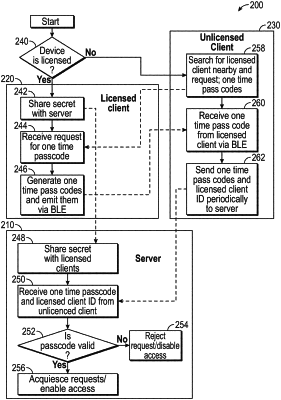| CPC G06F 21/105 (2013.01) [H04L 9/0872 (2013.01); H04L 9/3213 (2013.01); H04W 12/63 (2021.01); G06F 21/1014 (2023.08); G06F 21/1077 (2023.08); G06Q 2220/18 (2013.01)] | 20 Claims |

|
1. A computer-implemented method for geographically local license management, comprising:
transmitting, from a media server, a shared secret to a licensed client server broadcasting a wireless signal comprising a unique identifier associated with the licensed client server, wherein the licensed client server is logged into by a user based on user credentials;
periodically receiving, at the media server, an access token and the unique identifier of the licensed client server from an unlicensed client server based on a predefined timeout period, wherein the access token comprises an evolving one-time passcode;
scanning, by the unlicensed client server, a proximity of the licensed client server to the unlicensed client server;
identifying, by the unlicensed client server, the licensed client server is within less than a predetermined range of the unlicensed client server;
receiving, by the unlicensed client server, the access token and the unique identifier from the licensed client server based on the proximity of the licensed client server is less than the predetermined range of the unlicensed client server, wherein the user is not logged into the unlicensed client server;
transmitting, by the unlicensed client server, the access token and the unique identifier to the media server;
validating, by the media server, the access token based on the unique identifier and the shared secret with the licensed client server, wherein validating the access token comprises authenticating the evolving one-time passcode based on a configurable expiry time of the evolving one-time passcode;
enabling, by the media server, the unlicensed client server to access encrypted payloads of premium content of the media server upon a successful validation of the access token; and
decrypting, by the unlicensed client server, the encrypted payloads of premium content using the evolving one-time passcode as a secret key.
|